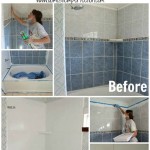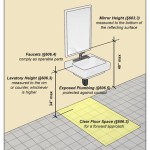How High Should A Backsplash Be In Bathroom?
Determining the appropriate height for a bathroom backsplash involves a balance of aesthetic preferences, functional requirements, and adherence to industry standards. A well-designed backsplash protects walls from water damage, adds a visual element to the space, and can simplify cleaning efforts. While there is no universally mandated height, understanding common practices and considering individual bathroom characteristics are crucial for making an informed decision.
The primary purpose of a bathroom backsplash is to shield the wall from splashes and spills emanating from the sink and countertop area. This protection is particularly important for materials susceptible to water damage, such as drywall or painted surfaces. Constant exposure to moisture can lead to mold growth, peeling paint, and structural deterioration. A properly installed backsplash acts as a barrier, preventing water from penetrating the wall and minimizing potential damage.
Furthermore, backsplashes contribute significantly to the overall aesthetics of a bathroom. They offer an opportunity to introduce color, texture, and pattern, enhancing the room's design scheme. The height of the backsplash influences the visual impact, affecting the perceived scale and style of the space. Different heights can create different effects, ranging from subtle accents to bold statements.
Cleaning is another important consideration when determining backsplash height. Areas around the sink are prone to soap scum, toothpaste splatters, and other forms of grime. A backsplash provides a smooth, non-porous surface that is easier to clean than a painted or textured wall. The taller the backsplash, the greater the area protected and the less maintenance required for the wall itself.
Standard Backsplash Heights and Considerations
The most common height for a bathroom backsplash is 4 inches. This height offers basic protection against splashes and is often considered a standard minimum for functional purposes. A 4-inch backsplash is typically sufficient for smaller sinks or powder rooms with minimal water usage. This height is also cost-effective, requiring less material and installation time compared to taller options. The brevity of this height makes it a subtle addition to the existing decor, providing functional benefits without overpowering other design elements.
A 4-inch backsplash is frequently used with prefabricated vanity tops, which may come with a matching 4-inch piece. This creates a cohesive look and simplifies the installation process. Pre-fabricated backsplashes are often available in the same material as the countertop, ensuring a seamless transition and consistent aesthetic. This option is particularly appealing for those seeking a quick and straightforward bathroom update.
However, a 4-inch backsplash might not be adequate for larger sinks, heavily used bathrooms, or households with children. In these situations, a taller backsplash is recommended to provide more comprehensive protection against water damage. The effectiveness of a 4-inch backsplash can be limited if the sink is frequently used or if the faucet is positioned in a way that encourages excessive splashing.
Mid-Height Backsplash Options
A mid-height backsplash typically ranges from 6 to 8 inches. This option provides enhanced protection compared to a 4-inch backsplash, while still maintaining a relatively understated appearance. A mid-height backsplash is suitable for bathrooms with moderate water usage and can be a good compromise between functionality and aesthetics.
Increasing the height to 6-8 inches allows for more decorative possibilities. It provides a larger canvas for incorporating tile patterns, textures, or accent colors. This height can also be used to visually connect the countertop with other elements in the bathroom, such as mirrors or lighting fixtures. The larger surface area allows for greater creativity and personalization.
Mid-height backsplashes can be particularly effective when paired with vessel sinks or wall-mounted faucets. These sink styles tend to be more prone to splashing, and the additional height provides added protection against water damage. The increased height can help contain water droplets and prevent them from reaching the wall behind the sink.
When considering a mid-height backsplash, it is important to consider the proportions of the bathroom. A backsplash that is too tall can overwhelm a small space, while one that is too short may not provide adequate protection. Carefully assess the size of the sink, the height of the countertop, and the overall dimensions of the bathroom to determine the optimal height.
Full Backsplash and Floor-to-Ceiling Options
A full backsplash extends from the countertop to the underside of the bathroom mirror or to a predefined height. This option offers maximum protection against water damage and creates a dramatic visual impact. Full backsplashes are often chosen for their aesthetic appeal and can serve as a focal point in the bathroom.
A full backsplash requires careful planning and execution, as it can significantly alter the perceived size and style of the bathroom. It is important to choose materials and colors that complement the existing décor and create a cohesive look. A full backsplash can be an effective way to add visual interest and personality to the space.
Floor-to-ceiling backsplashes offer the ultimate protection against moisture and create a striking design statement. These backsplashes extend from the countertop to the ceiling, covering the entire wall behind the sink. Floor-to-ceiling backsplashes are often used in modern or contemporary bathrooms to create a sleek and minimalist aesthetic.
While floor-to-ceiling backsplashes provide exceptional protection and visual appeal, they also require a significant investment in materials and installation. It is crucial to choose high-quality materials that are durable and easy to clean. Proper installation is essential to ensure a seamless and watertight finish.
The choice of material for a full or floor-to-ceiling backsplash is critical. Tile is a popular option due to its water resistance, durability, and variety of styles. Glass tile, stone tile, and ceramic tile are all suitable choices for a bathroom backsplash. The material should be chosen based on its aesthetic appeal, durability, and ease of maintenance.
The installation of a full or floor-to-ceiling backsplash requires careful attention to detail. The surface must be properly prepared to ensure that the tiles adhere securely. Grouting should be done meticulously to prevent water from penetrating the wall. It is often advisable to hire a professional tile installer to ensure a high-quality and long-lasting result.
Factors Influencing Backsplash Height Selection
Several factors influence the ideal height for a bathroom backsplash. These include the size of the sink, the style of the faucet, the frequency of use, and the overall design of the bathroom. Carefully considering these factors will help determine the most appropriate height.
The size of the sink is a primary consideration. Larger sinks are more prone to splashing, requiring a taller backsplash to provide adequate protection. Vessel sinks, in particular, tend to splash more than traditional undermount sinks, necessitating a taller backsplash.
The style of the faucet also plays a role. Faucets with a high arc or a strong water flow can cause more splashing than those with a low arc or a gentle flow. Wall-mounted faucets, in particular, can increase the risk of splashing, especially if they are positioned far from the sink basin.
The frequency of use is another important factor. Bathrooms that are used frequently, such as those in family homes, require a taller backsplash to withstand the constant splashing and spills. Bathrooms that are used less often, such as guest bathrooms, may only require a shorter backsplash.
The overall design of the bathroom should also be taken into account. The backsplash should complement the other elements in the room, such as the countertops, cabinets, and flooring. The height and style of the backsplash should be consistent with the overall aesthetic of the bathroom.
Budgetary constraints can also influence the choice of backsplash height. Taller backsplashes require more material and labor, which can increase the overall cost of the project. It is important to balance the desired level of protection and aesthetic appeal with the available budget.
Finally, personal preferences play a significant role in determining the ideal backsplash height. Some homeowners prefer a minimalist look with a short backsplash, while others prefer a more dramatic look with a full or floor-to-ceiling backsplash. The ultimate decision should reflect individual tastes and preferences.
In conclusion, selecting the appropriate height for a bathroom backsplash is a multifaceted decision. Carefully evaluating the functional requirements, aesthetic preferences, and bathroom characteristics will help in determining the optimal height for providing adequate protection, enhancing the room's design, and simplifying maintenance.

29 Bathroom Backsplash Height Best For

How To Design A Full Height Quartz Backsplash Grace In My Space

Do You Need A Backsplash For Your Bathroom Vanity Diamond Kitchen Bath

How To Design A Full Height Quartz Backsplash Grace In My Space

29 Bathroom Backsplash Height Best For

Should You Add Backsplash To Your Bathroom Vanity

Unique Bathroom Vanity Backsplash Ideas Glass Stone Ceramic Tile

Should A Bathroom Mirror Touch The Backsplash Localsearch
Backsplash Advice For Your Bathroom Would You Tile The Side Walls Too Designed

Requesting Advice For Bathroom Vanity Backsplash Height
Related Posts







